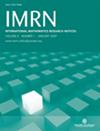dg-Hecke 对偶与张量积
IF 0.9
2区 数学
Q2 MATHEMATICS
引用次数: 0
摘要
我们继续[ 12]中开始的对单元范畴$D(G)$的研究。在同调层面上,我们把对偶函子 $R\underline{operatorname{Hom}}(-,k)$ 转移到了 dg 模块的派生范畴 $D(H_{U}^{\bullet})$。在这个过程中,我们开发了一种更通用、更精简的方法来处理[ 8] 中的反卷积 $\mathscr J$。我们还验证了 $D(G)$ 上的张量积对应于 dg 边上的操作张量积(参见 [ 5])。这使用了施努勒关于具有模型结构的 dg 范畴的一个结果。本文章由计算机程序翻译,如有差异,请以英文原文为准。
dg-Hecke Duality and Tensor Products
We continue our study of the monoidal category $D(G)$ begun in [ 12]. At the level of cohomology we transfer the duality functor $R\underline{\operatorname{Hom}}(-,k)$ to the derived category of dg-modules $D(H_{U}^{\bullet })$. In the process we develop a more general and streamlined approach to the anti-involution $\mathscr J$ from [ 8]. We also verify that the tensor product on $D(G)$ corresponds to an operadic tensor product on the dg-side (cf [ 5]). This uses a result of Schnürer on dg-categories with a model structure.
求助全文
通过发布文献求助,成功后即可免费获取论文全文。
去求助
来源期刊
CiteScore
2.00
自引率
10.00%
发文量
316
审稿时长
1 months
期刊介绍:
International Mathematics Research Notices provides very fast publication of research articles of high current interest in all areas of mathematics. All articles are fully refereed and are judged by their contribution to advancing the state of the science of mathematics.

 求助内容:
求助内容: 应助结果提醒方式:
应助结果提醒方式:


